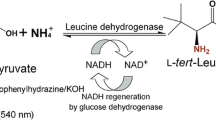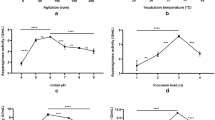Abstract
l-tert-Leucine (l-Tle) and its derivatives are extensively used as crucial building blocks for chiral auxiliaries, pharmaceutically active ingredients, and ligands. Combining with formate dehydrogenase (FDH) for regenerating the expensive coenzyme NADH, leucine dehydrogenase (LeuDH) is continually used for synthesizing l-Tle from α-keto acid. A multilevel factorial experimental design was executed for research of this system. In this work, an efficient optimization method for improving the productivity of l-Tle was developed. And the mathematical model between different fermentation conditions and l-Tle yield was also determined in the form of the equation by using uniform design and regression analysis. The multivariate regression equation was conveniently implemented in water, with a space time yield of 505.9 g L−1 day−1 and an enantiomeric excess value of >99 %. These results demonstrated that this method might become an ideal protocol for industrial production of chiral compounds and unnatural amino acids such as chiral drug intermediates.



Similar content being viewed by others
References
Agosta, E., Caligiuri, A., D’Arrigo, P., Servi, S., Tessaro, D., & Canevotti, R. (2006). Enzymatic approach to both enantiomers of N-Boc hydrophobic amino acids. Tetrahedron: Asymmetry, 17, 1995–1999.
Baker, P. J., Turnbull, A. P., Sedelnikova, S. E., Stillman, T. J., & Rice, D. W. (1995). A role for quaternary structure in the substrate specificity of leucine dehydrogenase. Structure, 3, 693–705.
Bea, H.-S., Park, H.-J., Lee, S.-H., & Yun, H. (2011). Kinetic resolution of aromatic β-amino acids by ω-transaminase. Chemical Communications, 47, 5894–5896.
Bommarius, A., Drauz, K., Hummel, W., Kula, M., & Wandrey, C. (1994). Some new developments in reductive Amtnation with cofactor regeneration. Biocatalysis, 10, 37–47.
Bommarius, A. S., Schwarm, M., & Drauz, K. (1998). Biocatalysis to amino acid-based chiral pharmaceuticals—examples and perspectives. Journal of Molecular Catalysis B: Enzymatic, 5, 1–11.
Fang, K.-T. (1980). The uniform design: application of number-theoretic methods in experimental design. Acta Math Appl Sinica, 3, 363–372.
Fang, Q., Yeung, H. W., Leung, H. W., & Huie, C. W. (2000). Micelle-mediated extraction and preconcentration of ginsenosides from Chinese herbal medicine. Journal of Chromatography. A, 904, 47–55.
Glassey, J., Gernaey, K. V., Clemens, C., Schulz, T. W., Oliveira, R., Striedner, G., & Mandenius, C. F. (2011). Process analytical technology (PAT) for biopharmaceuticals. Biotechnology Journal, 6, 369–377.
Guillén, M., Benaiges, M. D., & Valero, F. (2012). Biosynthesis of ethyl butyrate by immobilized recombinant Rhizopus oryzae lipase expressed in Pichia pastoris. Biochemical Engineering Journal, 65, 1–9.
Jiang, W., & Fang, B.-S. (2016). Construction and evaluation of a novel bifunctional phenylalanine–formate dehydrogenase fusion protein for bienzyme system with cofactor regeneration. Journal of Industrial Microbiology & Biotechnology, 43, 1–8.
Jiang, W., Lin, P., Yang, R. and Fang, B. (2016) Identification of catalysis, substrate, and coenzyme binding sites and improvement catalytic efficiency of formate dehydrogenase from Candida boidinii. Appl Microbiol Biotechnol. 1–13
Jiang, W., Sun, D., Lu, J., Wang, Y., Wang, S., Zhang, Y. and Fang, B. (2015) A cold-adapted leucine dehydrogenase from marine bacterium Alcanivorax dieselolei: characterization and l-tert-leucine production. Engineering in Life Science, 12.
Jiang, W., Wang, S., Yang, Z. and Fang, B. (2015) B12-independent glycerol dehydratase and its reactivase from Clostridia butyricum: optimizing cloning by uniform design logic. Engineering in Life Sciences.
Jiang, W., Xia, B. and Liu, Z. (2013) A serine hydroxymethyltransferase from marine bacterium Shewanella algae: isolation, purification, characterization and l-serine production. Microbiological Research.
Kragl, U., Kruse, W., Hummel, W., & Wandrey, C. (1996). Enzyme engineering aspects of biocatalysis: cofactor regeneration as example. Biotechnology and Bioengineering, 52, 309–319.
Kragl, U., Vasic-Racki, D., & Wandrey, C. (1996). Continuous production of L-tert-leucine in series of two enzyme membrane reactors. Bioprocess Engineering, 14, 291–297.
Krix, G., Bommarius, A., Drauz, K., Kottenhahn, M., Schwarm, M., & Kula, M.-R. (1997). Enzymatic reduction of α-keto acids leading to l-amino acids, d-or l-hydroxy acids. Journal of Biotechnology, 53, 29–39.
Kula, M.-R., Pohl, M., & Slusarczyk, H. (1997). sowie Verwendung dieser Formiatdeydrogenasen. Journal of Bacteriology, 179, P4480–P4485.
Kurbanoglu, E. B., Zilbeyaz, K., Taskin, M., & Kurbanoglu, N. I. (2009). Total production of (R)-3,5-bistrifluoromethylphenyl ethanol by asymmetric reduction of 3,5-bis(trifluoromethyl)-acetophenone in the submerged culture of Penicillium expansum isolate. Tetrahedron: Asymmetry, 20, 2759–2763.
Li, J., Pan, J., Zhang, J., & Xu, J.-H. (2014). Stereoselective synthesis of l-tert-leucine by a newly cloned leucine dehydrogenase from Exiguobacterium sibiricum. Journal of Molecular Catalysis B: Enzymatic, 105, 11–17.
Liu, S.-L., Song, Q.-X., Wei, D.-Z., Zhang, Y.-W., & Wang, X.-D. (2006). Preparation of optically pure tert-leucine by penicillin G acylase-catalyzed resolution. Preparative Biochemistry & Biotechnology, 36, 235–241.
Liu, S.-L., Wei, D.-Z., Song, Q.-X., Zhang, Y.-W., & Wang, X.-D. (2006). Effect of organic cosolvent on kinetic resolution of tert-leucine by penicillin G acylase from Kluyvera citrophila. Bioprocess and Biosystems Engineering, 28, 285–289.
Liu, W., Ma, H., Luo, J., Shen, W., Xu, X., Li, S., Hu, Y., & Huang, H. (2014). Efficient synthesis of l-tert-leucine through reductive amination using leucine dehydrogenase and formate dehydrogenase coexpressed in recombinant E. coli. Biochemical Engineering Journal, 91, 204–209.
Ma, J.-A. (2003). Recent developments in the catalytic asymmetric synthesis of α-and β-amino acids. Angew Chem Int Edit, 42, 4290–4299.
Menzel, A., Werner, H., Altenbuchner, J., & Gröger, H. (2004). From enzymes to “designer bugs” in reductive amination: a new process for the synthesis of L-tert-leucine using a whole cell-catalyst. Engineering in Life Sciences, 4, 573–576.
Ohshima, T., Nagata, S., & Soda, K. (1985). Purification and characterization of thermostable leucine dehydrogenase from Bacillus stearothermophilus. Arch Microbial, 141, 407–411.
Patel, R. (2003). Microbial/enzymatic synthesis of chiral pharmaceutical intermediates. Current Opinion in Drug Discovery & Development, 6, 902–920.
Pollard, D. J., & Woodley, J. M. (2007). Biocatalysis for pharmaceutical intermediates: the future is now. Trends in Biotechnology, 25, 66–73.
Schirwitz, K., Schmidt, A., & Lamzin, V. S. (2007). High-resolution structures of formate dehydrogenase from Candida boidinii. Protein Science, 16, 1146–1156.
Sekimoto, T., Fukui, T., & Tanizawa, K. (1994). Involvement of conserved lysine 68 of Bacillus stearothermophilus leucine dehydrogenase in substrate binding. The Journal of Biological Chemistry, 269, 7262–7266.
Seo, Y. M. (2011). Enzymatic synthesis of l-tert-leucine with branched chain aminotransferase. Journal of Microbiology and Biotechnology, 21, 1049–1052.
Slusarczyk, H., Felber, S., Kula, M. R., & Pohl, M. (2000). Stabilization of NAD-dependent formate dehydrogenase from Candida boidinii by site-directed mutagenesis of cysteine residues. European Journal of Biochemistry, 267, 1280–1289.
Solano, D. M., Hoyos, P., Hernáiz, M., Alcántara, A., & Sánchez-Montero, J. (2012). Industrial biotransformations in the synthesis of building blocks leading to enantiopure drugs. Bioresource Technology, 115, 196–207.
Stelkes-Ritter, U., Beckers, G., Bommarius, A., Drauz, K., Günther, K., Kottenhahn, M., Schwarm, M., & Kula, M.-R. (1997). Kinetics of peptide amidase and its application for the resolution of racemates. Biocatalysis and Biotransformation, 15, 205–219.
Turner, N. J., Winterman, J. R., McCague, R., Parratt, J. S., & Taylor, S. J. (1995). Synthesis of homochiral L-(S)-tert-leucine via a lipase catalysed dynamic resolution process. Tetrahedron Letters, 36, 1113–1116.
van der Donk, W. A., & Zhao, H. (2003). Recent developments in pyridine nucleotide regeneration. Current Opinion in Biotechnology, 14, 421–426.
Wang, Y., & Fang, K. T. (1981). A note on uniform distribution and experimental design. KeXue TongBao, 26, 485–489.
Wichmann, R., & Vasic-Racki, D. (2005). Cofactor regeneration at the lab scale. Advances in Biochemical Engineering/Biotechnology, 92, 225–260.
Wichmann, R., Wandrey, C., Bückmann, A. F., & Kula, M.-r. (1981). Continuous enzymatic transformation in an enzyme membrane reactor with simultaneous NAD(H) regeneration. Biotechnology and Bioengineering, 23, 2789–2802.
Xu, C. P., & Yun, J. W. (2003). Optimization of submerged-culture conditions for mycelial growth and exo-biopolymer production by Auricularia polytricha (wood ears fungus) using the methods of uniform design and regression analysis. Biotechnology and Applied Biochemistry, 38, 193–199.
Xu, Z., Singh, J., Schwinden, M. D., Zheng, B., Kissick, T. P., Patel, B., Humora, M. J., Quiroz, F., Dong, L., & Hsieh, D.-M. (2002). Process research and development for an efficient synthesis of the HIV protease inhibitor BMS-232632. Organic Process Research and Development, 6, 323–328.
Zhu, L., Wu, Z., Jin, J.-M. and Tang, S.-Y. (2016) Directed evolution of leucine dehydrogenase for improved efficiency of l-tert-leucine synthesis. Applied Microbiology Biotechnology, 1–9.
Acknowledgments
This work was supported by the State Key Program of the National Natural Science Foundation of China (No. 21336009), the National Natural Science Foundation of China (Nos. 41176111 and 41306124), the Foundation of South Oceanographic Research Center of China in Xiamen (No. 14GYY011NF11), and the Public Science and Technology Research Funds Projects of Ocean (No. 201505032-6).
Author information
Authors and Affiliations
Corresponding author
Ethics declarations
Conflict of Interest
The authors declare that they have no conflict of interest.
Authors’ Contributions
WJ and BSF designed the study. WJ carried out the experiments and wrote the paper. CZX carried out the optimizing of fermentation conditions. SZJ, TDZ, and SZW carried out the uniform design logic. BSF supervised the work and finalized the manuscript. All authors have read and approved the final manuscript.
Additional information
Highlights
• A multilevel factorial experimental design was performed for l-Tle production.
• A mathematical model relating fermentation conditions and conversion rate was established.
• The multivariate regression equation was verified and implemented in l-Tle synthesis.
• The space time yield, 505.9 g L−1 day−1, of the l-Tle was obtained in this work.
• The l-Tle was synthesized in the coenzyme regeneration system with an enantiomeric excess of >99 %.
Rights and permissions
About this article
Cite this article
Jiang, W., Xu, Cz., Jiang, Sz. et al. Establishing a Mathematical Equations and Improving the Production of l-tert-Leucine by Uniform Design and Regression Analysis. Appl Biochem Biotechnol 181, 1454–1464 (2017). https://doi.org/10.1007/s12010-016-2295-1
Received:
Accepted:
Published:
Issue Date:
DOI: https://doi.org/10.1007/s12010-016-2295-1




